one hundred cocktails
drinking with a purpose
← Off to the Races | The Algonquin Cocktail→
The Alamagoozlum Cocktail
27 Jan 2011
I’m pretty sure Ted Haigh has a goal with the first cocktail in his book, and it’s “put this book down unless you’re going to take this adventure seriously.” I don’t have any intent of reproducing the recipes in the book, but let’s just take a look at the ingredients we need to make the first cocktail in the book:
- egg white
- genever gin
- water
- Jamaica rum
- Chartreuse
- gomme syrup
- orange curaçao
- bitters
To this point in my life, a complicated cocktail is an Old Fashioned, and making a cocktail amounts to making the perfect martini, at best. The Alamagoozlum’s similarity in name to an amalgamation seems hardly a coincidence. If I’m going to take this adventure seriously, I needed to prove I could handle this little challenge. Let me illustrate, in pictures, what goes into an Alamagoozlum cocktail:
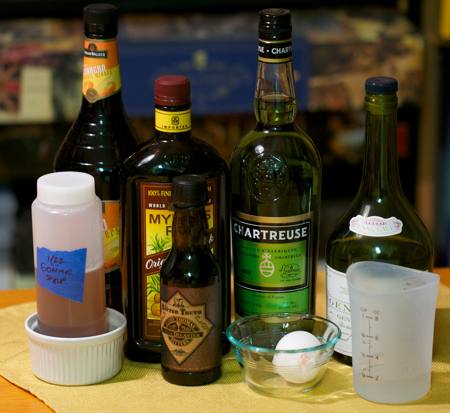
The first tricky bit was the gomme syrup. The book offers that gomme syrup is anachronistic and arguably redundant, given the egg white. Nonsense, I say! This is a book of anachronisms, it seems downright evasive to substitute simple syrup for gomme syrup! Of course, nobody sells gomme syrup anymore, so I had to figure out how to make it. First, I tracked down a supplier of gum arabic powder. I managed to secure a pound of the stuff from an herbal supplier on the Internet:
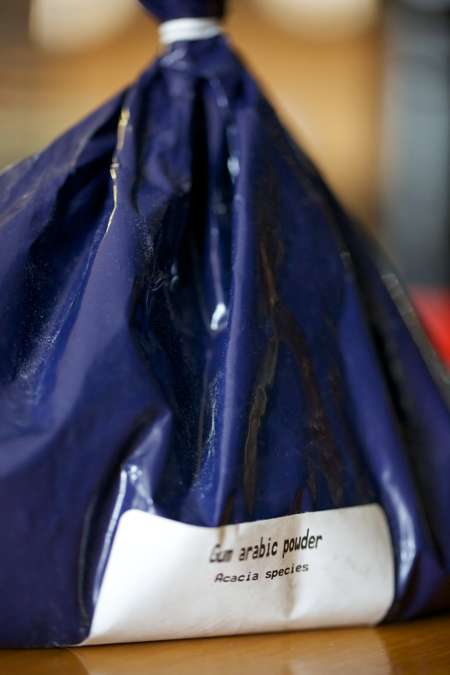
The powder has a funny feeling, is extremely fine, sticky, and coats everything. I made a solution of 2 ounces boiling water and 2 ounces gum arabic powder. This was a bit of an exercise in frustration, as the powder just formed a little seemingly hydrophobic raft on top of the boiling water. After about ten minutes of fighting with whisk, burner, and singed hand hair, I ended up with something not quite homogenous, but as good as it was going to get. I left it to cool to room temperature:
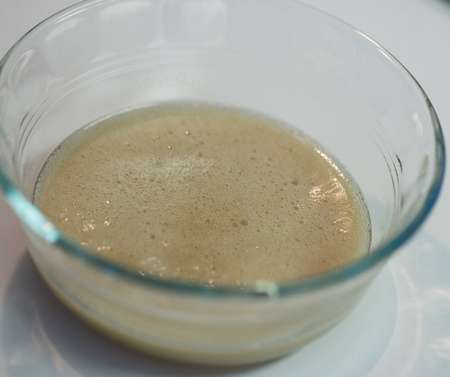
Essentially, gomme syrup is just a simple syrup with gum arabic in it, meant as an aide to emulsification, resulting in a “smoother, silkier feel on the tongue.” While the book advises not bothering, I can’t help but assume that it make a difference. Unfortunately, I haven’t been particularly scientific about this, and for reasons that will be clear later, I was a little discouraged and hampered in my ability to do a side-by-side comparison. The gomme syrup definitely has a flavor distinct from simple syrup, and I think it has effects beyond those provided by the egg white.
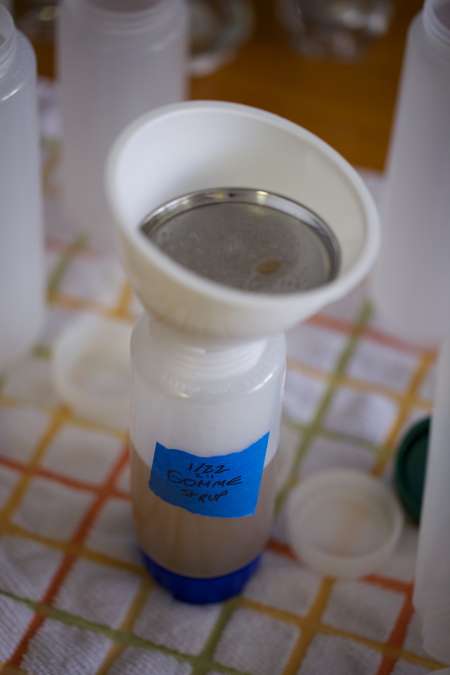
Onc cooled, I mixed it with a cup of sugar and half a cup of boiling water in a small saucepan – too small a saucepan, it turns out. Let’s just say a 1-quart butter warmer is not really sufficient for this particular job. I’m still wiping the burned-on glue-like crap off my stovetop. When you’re making even this quantity of gomme syrup, I recommend a much larger saucepan (at least two quart) to contain bubbling and also allow for whisking (you’re going to do a ton of it to try to get the crap to integrate). In any event, I strained the gluey mess into a fifo bottle, chilled it,and thus ended the saga of the gomme syrup.
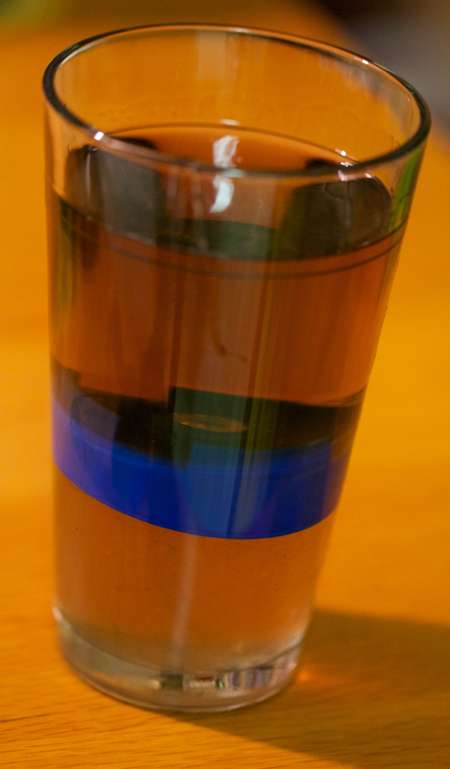
Okay, that’s not actually how the gomme syrup ends. There’s one last little treat. While I was mixing the first batch of ingredients, I gave the fifo bottle a good squeeze and … blasted the cap off the fifo bottle, along with most of the gomme syrup. The picture above shows roughly how things ended up – everything above the lid is liquor, everything below is gomme syrup. Of course, I did this after I dumped all of the liquor into the glass, meaning I would need to dump the expensive portion of the cocktail down the train. Bummer. I managed to scrape enough out of the fifo bottle (remember that this stuff has the consistency of partially cured epoxy resin) to make another round, but let this be a warning: Measure stuff into an intermediate jigger/measuring glass before adding to your mixing vessel.
Much ado in the book is made about the egg white being a “scary” ingredient. Statistically speaking, there’s what, a 1 in 10,000 chance of getting salmonella from raw egg? And hey, we’re tossing the egg white in with high-proof stuff like Chartreuse (and you better believe I’m using the real stuff, green, not that wimpy cousin yellow), right? Honestly, though, I wasn’t particularly concerned; raw never killed anybody (no, really). The book was correct in that dividing an egg white into two equal halves is a bit tricky (thus causing the in-book recipe to yield six servings … ouch), but I manage to finagle it somehow. Pre-mixing, the solution sure looked gross as hell, though:

Damn, I think I threw up a bit in my mouth just now. It wasn’t pleasant looking at the time, either. Whatever. Into the shaker with ice it went, and I shook until the thing frosted over. The end results looked something like this:
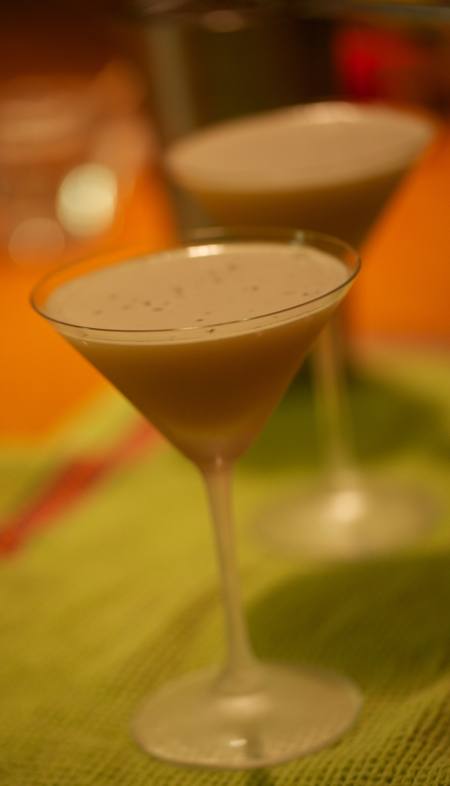
I should note I used The Bitter Truth’s aromatic bitters instead of the Angostura bitters, mostly because I’m not as fond of Angostura bitters … especially when half an ounce of the stuff is being dumped into a cocktail.
I like simple things. I tend to assume that complicated preparations, recipes, and ingredients lead to complicated results – hard to get right and often complicated more for the point of being complicated than for a good reason. With that said, the Alamagoozlum cocktail is an interesting beast. It has a nice gingerbread/licorice flavor. Somewhat reminiscent of buttered rum, except it’s cold and way more complicated. Consistency is very thick; it coats the mouth like heavy cream or a melting milkshake. The bitters note is pronounced (not surprising given the volume), but using a high-quality bitters makes this intriguing rather than distracting – this is a cocktail that features bitters as a component. The flavors of the Chartreuse are also teased out, though any subtleties in the milder ingredients are blasted away – don’t bother with high quality rums or genever.
I don’t know if I would make one again. It is certainly an interesting conversation piece and a complex and contemplative adventure, but it seems a little too much work for the end result – a good sazerac is, I think, more compelling and straightforward.
Copyright © 2011 - 2012 Aaron N. Tubbs